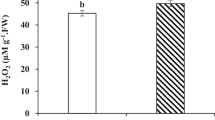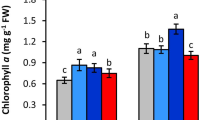Abstract
This research was carried out to evaluate the effects of salicylic acid (1 mM) and putrescine (1 mM) on mitigation of oxidative stress caused by different irrigation intervals (70; 70 → 90 → 110 → 130 → 150; 70 → 100 → 130 → 150 and 150 mm evaporation, respectively). Two experiments with split plot arrangements in three replications were performed in 2 consecutive years of 2017 and 2018. Although, the activities of peroxidase, catalase, superoxide dismutase, and ascorbate peroxidase were stimulated by drought stress, lipid peroxidation and H2O2 were also enhanced due to this stress. This was led to a reduction in relative water content of leaves, membrane stability, chlorophyll content, oil percentage, and grain and oil yields under stressful conditions. Foliar sprays putrescine and especially salicylic acid further increased the antioxidant enzymes activities, water content, membrane integrity and chlorophyll pigment under different irrigation intervals. These superiorities of salicylic acid and putrescine treatments were led to a high improvement in grain and oil yields of rapeseed. It was concluded that gradual water deficit and application of these growth regulators can alleviate some of the injuries of water deficit on field production of rapeseed.
Similar content being viewed by others
References
Ahmad A, Hayat S, Fariduddin Q, Ahmad I (2001) Photosynthetic efficiency of plants of Brassica juncea treated with chlorosubstituted auxins. Photosynthetica 39(4):565–568
Alcázar R, Planas J, Saxena T, Zarza X, Bortolotti C, Cuevas J, Bitrián M, Tiburcio AF, Altabella T (2010) Putrescine accumulation confers drought tolerance in transgenic Arabidopsis plants over-expressing the homologous Arginine decarboxylase 2 gene. Plant Physiol Biochem 48(7):547–552
Alvarez ME (2000) Salicylic acid in the machinery of hypersensitive cell death and disease resistance. In: Lam E, Fukuda H, Greenberg J (eds) Programmed cell death in higher plants. Springer, Dordrecht, pp 185–198
Arnon DI (1949) Copper enzymes in isolated chloroplasts. Polyphenoloxidase in Beta vulgaris. Plant Physiol 24(1):1–15
Ashraf M (2009) Biotechnological approach of improving plant salt tolerance using antioxidants as markers. Biotechnol Adv 27(1):84–93
Ashraf M (2010) Inducing drought tolerance in plants: some recent advances. Biotechnol Adv 28(1):169–183
Ashraf M, Foolad MR (2007) Roles of glycine betaine and proline in improving plant abiotic stress resistance. Environ Exp Bot 59(2):206–216
Azooz MM, Youssef AM, Ahmad P (2011) Evaluation of salicylic acid (SA) application on growth, osmotic solutes and antioxidant enzyme activities on broad bean seedlings grown under diluted seawater. Int J Plant Physiol Biochem 3(14):253–264
El-Beltagi HS, Mohamed AA, Mekki BB (2011) Differences in some constituents, enzymes activity and electrophoretic characterization of different rapeseed (Brassica napus L.) cultivars. Analele Universitatii din Oradea, Fascicula Biologie 18(1):39–46
El-Tayeb MA (2005) Response of barley grains to the interactive effect of salinity and salicylic acid. Plant Growth Regul 45:215–224
Faizan A, Asghari B, Asia N (2012) Effects of plant growth regulators on growth and oil quality of canola (Brassica napus L) under drought stress. Pak J Bot 44(6):1873–1880
Farhangi-Abriz S, Ghassemi-Golezani K (2016) Improving amino acid composition of soybean under salt stress by salicylic acid and jasmonic acid. J Appl Bot Food Qual 89:243–248
Farhangi-Abriz S, Ghassemi-Golezani K (2018) How can salicylic acid and jasmonic acid mitigate salt toxicity in soybean plants? Ecotoxicol Environ Saf 147:1010–1016
Farooq M, Wahid A, Lee D (2009) Exogenously applied polyamines increase drought tolerance of rice by improving leaf water status, photosynthesis and membrane properties. Acta Physiol Plant 31:937–945
Flexas J, Medrano H (2002) Drought-inhibition of photosynthesis in C3 plants: stomatal and nonstomatal limitations revisited. Ann Bot 89(2):183–189
Ghassemi S, Ghassemi-Golezani K, Salmasi SZ (2019) Changes in antioxidant enzymes activities and physiological traits of ajowan in response to water stress and hormonal application. Sci Hortic 246:957–964
Ghassemi-Golezani K, Hosseinzadeh-Mahootchi A (2015) Improving physiological performance of safflower under salt stress by application of salicylic acid and jasmonic acid. WALIA J 31:104–109
Ghassemi-Golezani K, Lotfi R (2015) The impact of salicylic acid and silicon on chlorophyll a fluorescence in mung bean under salt stress. Russ J Plant Physiol 62(5):611–616
Ghassemi-Golezani K, Nikpour-Rashidabad N (2017) Seed pretreatment and salt tolerance of dill: osmolyte accumulation, antioxidant enzymes activities and essence production. Biocatal Agric Biotechnol 12:30–35
Ghassemi-Golezani K, Ghassemi S, Yaghoubian I (2016) Salicylic acid regulate physiological performance of milk thistle (Silybum marianum L.) under water stress. Adv Biores 7(4):34–40
Ghassemi-Golezani K, Ghassemi S, Zehtab Salmasi S (2018) Changes in essential oil-content and composition of ajowan (Carum copticum L.) seeds in response to growth regulators under water stress. Sci Hortic 231:219–226
Gholipoor M, Sinclair TR, Raza MAS, Loffler C, Cooper M, Messina CD (2013) Maize hybrid variability for transpiration decrease with progressive soil drying. J Agron Crop Sci 199(1):23–29
Gill RA, Zhang N, Ali B, Farooq MA, Xu J, Gill MB, Mao B, Zhou W (2016) Role of exogenous salicylic acid in regulating physio-morphic and molecular changes under chromium toxicity in black-and yellow-seeded Brassica napus L. Environ Sci Pollut Res 23(20):20483–20496
Gueta-Dahan Y, Yaniv Z, Zilinskas BA, Ben-Hayyim G (1997) Salt and oxidative stress: similar and specific responses and their relation to salt tolerance in citrus. Planta 203(4):460–469
Gunasekera CP, Martin LD, Siddique KHM, Walton GH (2006) Genotype by environment interactions of Indian mustard (Brassica juncea L.) and canola (B. napus L.) in Mediterranean-type environments: 1. Crop growth and seed yield. Eur J Agron 25(1):1–12
Hayat Q, Hayat S, Irfan M, Ahmad A (2010) Effect of exogenous salicylic acid under changing environment: a review. Environ Exp Bot 68(1):14–25
Ianovici N (2011) Histoanatomical and ecophysiological studies on some halophytes from Romania—Plantago schwarzenbergiana. Ann West Univ Timisoara Ser Biol 14:53–64
Jaleel CA, Lakshmanan GM, Gomathinayagam M, Panneerselvam R (2008) Triadimefon induced salt stress tolerance in Withania somnifera and its relationship to antioxidant defense system. S Afr J Bot 74(1):126–132
Janero DR (1990) Malondialdehyde and thiobarbituric acid-reactivity as diagnostic indices of lipid peroxidation and peroxidative tissue injury. Free Radic Biol Med 9(6):515–540
Khan W, Prithiviraj B, Smith DL (2003) Photosynthetic responses of corn and soybean to foliar application of salicylates. J Plant Physiol 160(5):485–492
Kong L, Ashraf U, Cheng S, Rao G, Mo Z, Tian H, Pan S, Tang X (2017) Short-term water management at early filling stage improves early-season rice performance under high temperature stress in South China. Eur J Agron 90:117–126
Minocha R, Majumdar R, Minocha CS (2014) Polyamines and abiotic stress in plants: a complex relationship. Front Plant Sci 5:175–193
Montillet JL, Chamnongpol S, Rustérucci C, Dat J, Van de Cotte B, Agnel JP, Battesti C, Inzé D, Van Breusegem F, Triantaphylides C (2005) Fatty acid hydroperoxides and H2O2 in the execution of hypersensitive cell death in tobacco leaves. Plant Physiol 138(3):1516–1526
Munns R, James RA, Lauchli A (2006) Approaches to increasing the salt tolerance of wheat and other cereals. J Exp Bot 57(5):1025–1043
Nakano Y, Asada K (1981) Hydrogen peroxide is scavenged by ascorbate-specific peroxidase in spinach chloroplasts. Plant Cell Physiol 22(5):867–880
Radhakrishnan R, Lee I (2013) Spermine promotes acclimation to osmotic stress by modifying antioxidant, abscisic acid, and jasmonic acid signals in soybean. J Plant Growth Regul 32(1):22–30
Sadaqat HA, Tahir MHN, Hussain MT (2003) Physiogenetic aspects of drought tolerance in canola (Brassica napus). Int J Agric Biol 5(4):611–614
Sakhabutdinova R, Fatkhutdinova R, Bezrukova V, Shakirova M, Srivastava MK, Dwivedi UN (2000) Delayed ripening of banana fruit by Salicylic acid. Plant Sci 158:87–96
Sakhabutdinova AR, Fatkhutdinova DR, Bezrukova MV, Shakirova FM (2003) Salicylic acid prevents the damaging action of stress factors on wheat plants. Bulg J Plant Physiol 21:314–319
Shakirova FM (2007) Role of hormonal system in the manifestation of growth promoting and anti-stress action of salicylic acid. In: Ahmad A, Hayat S (eds) Salicylic acid. A plant hormone. Springer, Dordrecht
Shankar NK, Khan SR, Srivastava HS (2001) The response of nitrate reductase activity and nitrate assimilation in mize roots to growth regulators at acidic pH. Biol Plant 44(4):599–601
Singh B, Usha K (2003) Salicylic acid induced physiological and biochemical changes in wheat seedlings under water stress. Plant Growth Regul 39:137–141
Singh BK, Sharma SR, Singh B (2010) Antioxidant enzymes in cabbage: variability and inheritance of superoxide dismutase, peroxidase and catalase. Sci Hortic 124(1):9–13
Singh AP, Dixit G, Kumar A, Mishra S, Kumar N, Dixit S, Singh PK, Dwivedi S, Trivedi PK, Pandey V, Dhankher OP (2017) A protective role for nitric oxide and salicylic acid for arsenite phytotoxicity in rice (Oryza sativa L.). Plant Physiol Biochem 115:163–173
Takahashi T, Kakehi JI (2009) Polyamines: ubiquitous polycations with unique roles in growth and stress responses. Ann Bot 105(1):1–6
Talaat IM, el-din Gamal KM (2007) Physiological effect of putrescine and heat hardening on Nigella sativa L. plants. Int J Agric Biol 7(3):358–362
Velikova V, Yordanov I, Edreva A (2000) Oxidative stress and some antioxidant systems in acid rain-treated bean plants: protective role of exogenous polyamines. Plant Sci 151(1):59–66
Yamaguchi K, Takahashi Y, Berberich T, Imai A, Takahashi T, Michael AJ, Kusano T (2007) A protective role for the polyamine spermine against drought stress in Arabidopsis. Biochem Biophys Res Commun 352(2):486–490
Yiu J, Liu C, Fang DY, Lai Y (2009) Waterlogging tolerance of Welsh onion (Allium fistulosum L.) enhanced by exogenous spermidine and spermine. Plant Physiol Biochem 47(8):710–716
Zhang LX, Li SQ, Li SX, Liang ZS (2011) Modulation of plant growth, water status and antioxidative system of two maize cultivars (Zea mays L.) induced by exogenous glycinebetaine under long term mind drought. Pak J Bot 43:1587–1594
Zhang LX, Gao M, Zhang LS, Li BZ, Han MY, Alva KA, Ashraf M (2013) Role of exogenous glycinebetaine and humic acid in mitigating drought stress-induced adverse effects in Malus robusta seedlings. Turk J Bot 37(5):920–929
Zhang LX, Lai JH, Liang ZS, Ashraf M (2014) Interactive effects of sudden and gradual drought stress and foliar-applied glycinebetaine on growth, water relations, osmolyte accumulation and antioxidant defence system in two maize cultivars differing in drought tolerance. J Agron Crop Sci 200(6):425–433
Acknowledgements
We appreciate the financial support of this research by the University of Tabriz.
Author information
Authors and Affiliations
Corresponding author
Additional information
Communicated by P. Wojtaszek.
Publisher's Note
Springer Nature remains neutral with regard to jurisdictional claims in published maps and institutional affiliations.
Rights and permissions
About this article
Cite this article
Ghassemi-Golezani, K., Bilasvar, H.M. & Nassab, A.D.M. Improving rapeseed (Brassica napus L.) plant performance by exogenous salicylic acid and putrescine under gradual water deficit. Acta Physiol Plant 41, 192 (2019). https://doi.org/10.1007/s11738-019-2986-7
Received:
Revised:
Accepted:
Published:
DOI: https://doi.org/10.1007/s11738-019-2986-7




